Fusion Algorithm-Based Temperature Compensation Method for High-G MEMS Accelerometer
Abstract
In recent years, High-G MEMS accelerometers have been widely used in aviation, medicine, and other fields. So it is extremely important to improve the accuracy and performance of High-G MEMS accelerometers. For this purpose, we propose a fusion algorithm that combines EMD, wavelet thresholding, and temperature compensation to process measurement data from a High-G MEMS accelerometer. In the fusion algorithm, the original accelerometer signal is first decomposed by EMD to obtain the intrinsic mode function (IMF). Then, sample entropy (SE) is used to divide the IMF components into three segments. The noise segment is directly omitted, wavelet thresholding is performed on the mixing segment, and a GA-BP performs temperature compensation on the drift segment. Finally, signal reconstruction is implemented. Later, a comparative analysis is carried out on the results from four models: EMD, wavelet thresholding, EMD + wavelet thresholding, and EMD + wavelet thresholding + temperature compensation. The experimental data show that the acceleration random walk change from 1712.66 g/h/Hz0.5 to 79.15 g/h/Hz0.5 and the zero-deviation stability change from 49275 g/h to 774.7 g/h. This indicates that the fusion algorithm (EMD + wavelet thresholding + temperature compensation) not only effectively suppresses the noise of high-frequency components but also compensates for temperature drift in the accelerometer.
1. Introduction
MEMS accelerometers are fabricated using MEMS technology [1]. The High-G MEMS accelerometer is a general term for high-range accelerometers. It is a key component in the inertial testing and control of MEMS technology for fusion intrusion. The main application of the High-G MEMS accelerometer is the measurement and control of speed changes in high-speed motion carriers during start-up and operation [2, 3]. Thus, the High-G MEMS accelerometer is widely used in the aerospace field for the precise control of missiles and intelligent projectiles [4]. Therefore, research on this type of sensor and the associated MEMS system is extremely significant. Many High-G MEMS accelerometers are the most susceptible component of the input system and critically affect the accuracy of the system. The effects of the accelerometer itself and the signal hardware acquisition circuit result in the superposition of the acquired accelerometer signal and a large number of noise signals. Direct analysis of the output signal inevitably produces an error that requires corresponding denoising processing [5]. The traditional Fourier transform filter operates on the difference between the frequency distributions of the signal and the noise. Thus, an undesirable frequency component can be removed by selecting an appropriate filter in the frequency domain to achieve denoising [6]. However, a precondition for processing using Fourier transforms is that the signal satisfies the stationary assumption. It is often difficult to denoise nonstationary or transient signals using frequency domain filtering methods, because the Fourier transform is not applicable to the nonstationary signals that are encountered in practice [7]. In empirical mode decomposition, the data themself are used to adaptively decompose nonstationary signals, such that arbitrary nonlinear and nonstationary signals can be processed [8]. In this method, a complex signal is decomposed into several eigenmode functions arranged in frequency. And, the decomposed components can be used to reconstruct the original signal without energy loss [9]. The wavelet transform is a localized analysis in time (space) frequency. It can be automatically adapted to the requirements of time-frequency signal analysis. Wavelet thresholding, based on the wavelet transform, has become the most commonly used method for denoising [10]. Conventional denoising methods tend to remove all of the high-frequency components of a signal that contain noise, thereby also eliminating the desirable components of a signal in the high-frequency range. Wavelet thresholding can solve this problem [11]. Therefore, combining EMD with wavelet thresholding is an effective method to suppress noise. However, the main material that is used in MEMS acceleration is silicon, which is greatly affected by temperature. Thus, ambient temperature changes produce measurement errors in the accelerometer. So, it is very important to study the temperature characteristics of accelerometers and compensate for temperature drift. At present, hardware and software methods are commonly used for temperature compensation. Hardware compensation generally improves the accuracy of the accelerometer by changing the material, process, structure, and working environment of the accelerometer. However, the hardware compensation process is complicated. In the software compensation, a model is developed for accelerometer temperature compensation. To develop this temperature model, it is usually necessary to design a special temperature control box or complex test equipment, such as an independent high-precision temperature control box, an indexing table, or a temperature control turntable. The temperature error compensation model that has been developed by numerical analysis of test data for MEMS accelerometers is economical and practical. It is a part of a current research trend. Temperature compensation can improve the accuracy of an accelerometer and its output signal [12, 13]. For this purpose, we develop a fusion algorithm that combines EMD with wavelet thresholding and temperature compensation. This algorithm is used to process measurement data from a MEMS accelerometer. In the fusion algorithm, EMD decomposition is first performed on the original accelerometer signal to obtain the IMF components, which are then segmented using sample entropy (SE). The noise segment is directly rounded off, and the mixing segment is processed by wavelet thresholding. And the drift segment is processed by the genetic wavelet neural network algorithm (GA-BP) for temperature compensation. The reconstructed signal exhibits improved the accuracy. Experimental data show that, after using the fusion algorithm, the acceleration random walk and zero-deviation stability change from 1712.66 g/h/Hz0.5 and 49275 g/h to 79.15 g/h/Hz0.5 and 774.7 g/h, respectively. This indicates that the fusion algorithm not only effectively suppresses the noise of high-frequency components but also compensates for temperature drift in the accelerometer.
In this paper, we introduce the structure and working principle of a High-G MEMS accelerometer and develop a fusion algorithm. The article is divided into five sections. The algorithm is described in Section 2; an introduction to accelerometers is presented in Section 3; the temperature experiment is described in Section 4 along with an analysis of the experimental results; and the final section serves as the conclusion.
2. Algorithm
2.1. Empirical Mode Decomposition (EMD)
- (1)
First, all local maximum and minimum points of the determined signal are determined. Then, all obtained local maximum points are connected using a cubic spline curve to fit the maximum envelope Smax(t). All resulting local minimum points are fitted to the minimum envelope Smin(t). At this point, all data of the signal are contained between the maximum envelope and the minimum envelope.
- (2)
After fitting the upper envelope line Smax(t) and the lower envelope line Smin(t), the average of the two is obtained. It can be known that
- (3)
Then, subtract m1(t) from the original signal X(t) to obtain a residual component h1(t) with the low frequency component removed, namely,
-
Determine whether the remaining component h1(t) meets the conditions defined by the intrinsic modal function. If so, the remaining component h1(t) is preserved as an IMF component.
- (4)
If h1(t) does not satisfy the conditions defined by IMF, take h1(t) as the original data and repeat steps (2)∼(3), as follows:
- (5)
r1(t) is obtained by subtracting the first IMF component a1(t) from the original signal X(t):
-
r1(t) is taken as the original signal again, and then the above steps are repeated to obtain a2(t) of the IMF component of the second X(t), which is repeated n times until the n-th IMF component an(t) is obtained, or when the residual component rn(t) is a constant or a monotone function, the EMD decomposition process is terminated.
- (6)
Finally, the n-order IMF component and residual component rn(t) can be fitted to form the original signal X(t), as follows:
2.2. Wavelet Threshold Denoising
- (1)
Wavelet decomposition of the signal is performed. The wavelet basis function is selected. The number of layers to be decomposed is determined.
- (2)
A threshold is selected to quantify the high-frequency wavelet coefficients that are obtained using the hard or soft threshold methods.
- (3)
Wavelet reconstruction is performed. The signal is reconstructed using the low-frequency coefficients of the lowest layer after wavelet decomposition and the high-frequency coefficients of all layers after wavelet decomposition.
Threshold processing methods include hard and soft threshold methods. In the hard threshold method, the wavelet coefficients above a given threshold are unchanged. The wavelet coefficients below this threshold of each subspace are set to zero. In the soft threshold method, the wavelet coefficients are shrunk to zero according to a fixed quantity and the denoised signal is reconstructed using the new wavelet coefficients.
The criterion of threshold determination includes fixed stein unbiased estimation (iRgrsure), adaptive stein unbiased estimation (Heusrure), minimax criterion (Minimaxi), and fixed threshold criterion (Sqtwolog).
2.3. SE (Sample Entropy)
Sample entropy (SE) is a method for measuring the complexity of a time series that improves upon the approximate entropy (AE) method [18]. SE increases the precision of approximate entropy. It offers two major advantages over approximate entropy. First, data segments are not compared in SE, thereby reducing the dependence on the length of the time series. This reduces the error in the approximate entropy and makes the method insensitive to lost data. Second, SE is more consistent than AE. That is, changes in the parameters k and h have the same effect on the SE. The lower the value of the SE, the higher is the self-similarity of the sequence. The larger the value of the SE, the more complex is the sample sequence. At present, SE has applications in assessing the complexity of physiological time series (EEG, sEMG, etc.) and diagnosing pathological conditions [19].
- (1)
A sequence of vectors of dimension k, Xk(1), …, Xk(T − k + 1) where Xk(m) = {x(m), x(m + 1), …, x(m + k − 1)}, 1 ≤ m ≤ (T − k + 1). These vectors represent k consecutive values of x from point m.
- (2)
The distance d[Xk(m), Xk(n)] between the vector Xk(m) and Xk(n) is defined as the absolute value of the biggest difference between the two corresponding elements, that is,
(8)
- (3)
For a given Xk(m), the number of n (1 ≤ n ≤ T − k, n ≠ 2) whose distance between Xk(m) and Xk(n) is less than or equal to h is counted and denoted as Bm. For 1 = m ≤ T − k, we define
- (4)
Bk(h) is defined as
- (5)
The dimension is increased to K + 1. The number of distances between XK+1(m) and XK+1(n)(1 ≤ m ≤ N − k, n ≠ m) that are less than h is computed and denoted as Cm. is defined as follows:
- (6)
Ck(h) is defined as follows:
The value of the SE depends on the values of k and h, making these values highly significant calculation parameters. According to research results that have been presented in the literature [20], the SE that is calculated using k = 1 or 2 and h = 0.1∼0.25 std (std is the standard deviation of the original data) exhibits relatively reasonable statistical characteristics. In this study, we take k = 1 and h = 0.1 std.
2.4. Establishment of Temperature Compensation Model of GA-BP Neural Network
2.4.1. BP Temperature Compensation Model
A backpropagation (BP) neural network is trained according to the error backpropagation algorithm. This multilayer feedforward neural network is the most widely used neural network [21]. The learning process of the BP neural network consists of two stages: the forward propagation of the signal and the backpropagation of the error. These two stages occur cyclically, during which the weights of the layers are continuously adjusted. The learning process does not end until the error in the network output is acceptable or proceeds to a preset number of loops. The neural network algorithm does not need to know the specific relationship between the input vector. The output only needs to determine the input vector factor to obtain the target output through network training and learning. Therefore, the scale factor and the zero-bias temperature compensation model can be used with a three-layer structure network. That is, the temperature and the adjacent temperature difference are taken as input variables, the number of hidden layers is one, and the scale factor and the zero-bias voltage value serve as network outputs. The topology of the network structure topology is shown in Figure 1.
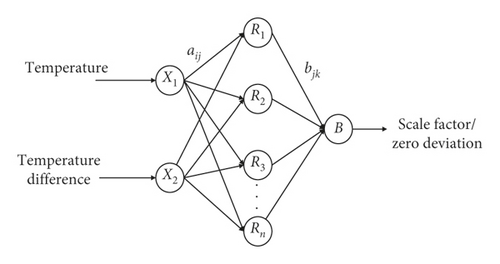
The corresponding transformation relationship of each layer is as follows.
2.4.2. GA-BP Temperature Compensation Model
- (1)
Determining the sample number of input factor temperature, temperature difference, and output factor scale factor/zero deviation, and setting the fitness function, generate the weight value, and threshold value randomly to generate the initial population and code.
- (2)
The network output of the corresponding chromosome is obtained through the network calculation of the scale factor and zero-deviation input sample.
- (3)
Calculating the fitness of the chromosome using the fitness function.
- (4)
Regenerating, crossing, and mutating to produce a new generation of population.
- (5)
The termination condition is reached, and the global optimal network weight and threshold are obtained; otherwise, the above step (3) is returned.
The GA-BP temperature compensation model of the High-G MEMS accelerometer was completed by the above method.
The design flow chart of BP neural network optimization by GA is shown in Figure 2:
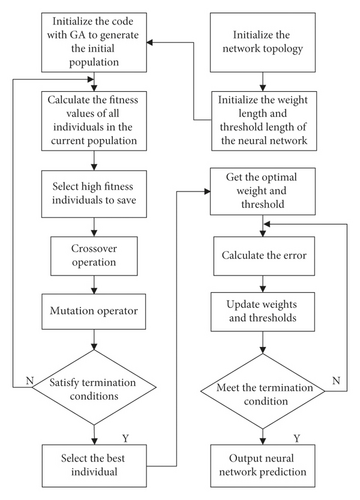
In this study, according to the empirical formula m = 2n + 1, the number of hidden layer nodes can be determined to be 5, where m is the number of hidden layer nodes and n is the number of input variables. The learning rate will affect the training times and network oscillation, so the learning rate Lr is 0.6 and the network accuracy is 0. 0001, thus completing the BP neural network structure parameter setting.
The size of the population determines the complexity of the chromosome. To adapt to chromosomal evolutionary ability, the group size is set to 30; the chromosome coding is in the binary form. A chromosome coding length of 15 is selected to improve the optimization efficiency. The advantages and disadvantages of the operator limit the search scope of the feasible domain. The law of survival of the fittest in nature is simulated. The roulette method is used to select the offspring. To truly reflect the impact of nature on populations, the crossover operator uses 0.7. To ensure population diversity to avoid malformation of the population which can affect the search mechanism, the crossover operator is set to 0.01. Thus, all of the parameters are set for the entire network model of GA-BP.
2.5. EMD, Wavelet Threshold, and Temperature Compensation Fusion Algorithm
- (1)
The original signal is decomposed by EMD to obtain the modal components
- (2)
The SE algorithm is used to divide the IMF components into three segments: a noise segment, a mixing segment, and a drift segment
- (3)
The noise segment is directly rounded off, the mixing segment is processed using wavelet thresholding, and temperature compensation is performed on the drift segment
The two segments perform signal reconstruction to obtain the final signal. The flow of the fusion algorithm is shown in Figure 3.

3. Structure and Structural Parameters of the High-G MEMS Accelerometer
The original signal collected in this paper comes from a newly designed and manufactured High-G MEMS accelerometer [23]. Its structure is in the form of four-beam islands. The beam and mass are rectangular and easy to manufacture. The beam and mass structure are supported by a frame and connected to the bottom [24, 25]. Its structure diagram and size are shown in Figure 4.
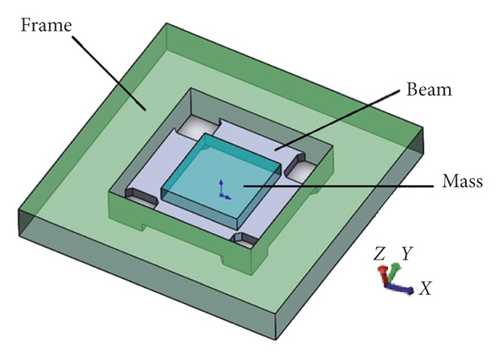
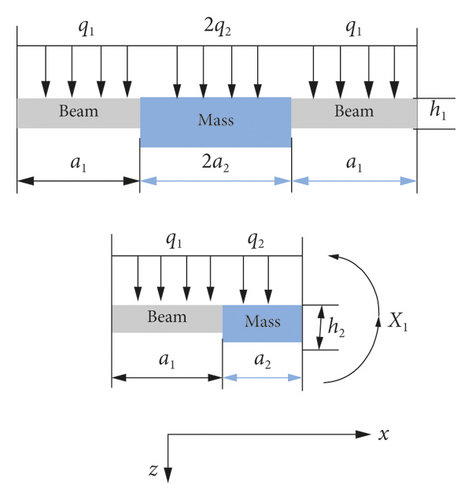
The length and width parameters of the beam were optimized using the MATLAB simulation method. The software is used to analyze the relationship between deflection, stress, mechanical sensitivity, and resonant frequency versus the length and width of the accelerometer. And Figure 5 is drawn. After comprehensive consideration of various factors, the structural parameters were modified and optimized, as shown in Table 1:
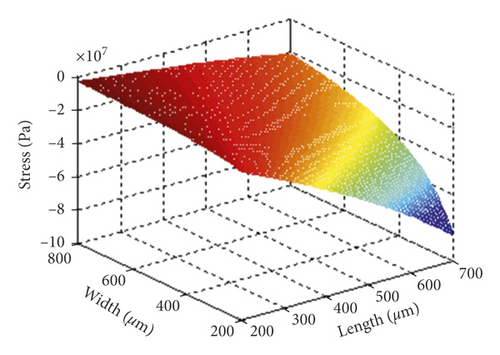
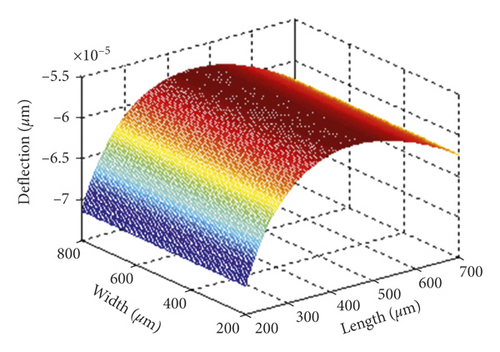
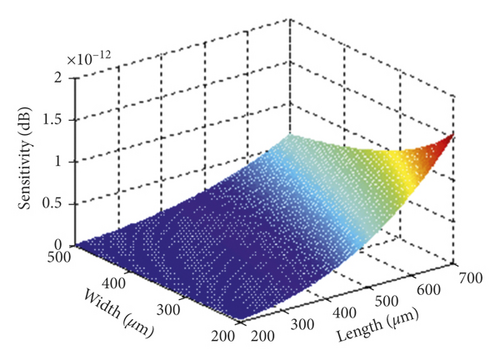

| Mass | Beam | |||||
|---|---|---|---|---|---|---|
| Parameters | Length (a1) | Width (b1) | Height (c1) | Length (a2) | Width (b2) | Height (c1) |
| Size (μm) | 800 | 800 | 200 | 350 | 800 | 80 |
The first-order mode is simulated and analyzed by ANSYS software, as shown in Figure 6. The first mode mass moves along the Z axis, and its resonant frequency is 408 kHz, which is the working mode.
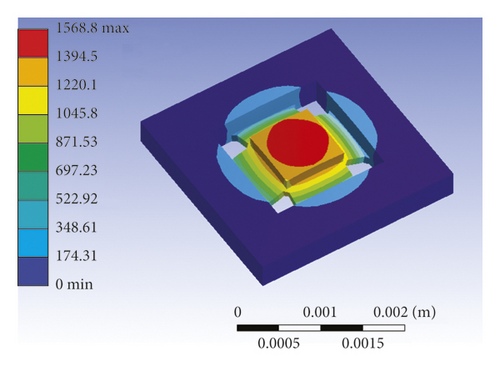
The structure of the High-G MEMS accelerometer is made of silicon and bonding on glass, and the SEM photos and CCD photos of the accelerometer structure are shown in Figure 7.
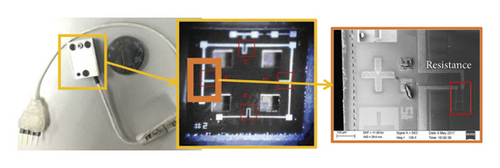
4. Experiment and Result Analysis
4.1. Temperature Experiment
The equipment that is used in the temperature experiment consists of a temperature-controlled oven. A GWINSTEK GPS-4303C power supply provides a +5 V voltage to the High-G MEMS accelerometer, which is placed in the oven. The thermal resistance method is used to obtain the real-time temperature in the body of the accelerometer, and this value is synchronized with the High-G MEMS accelerometer output. The device is shown in Figure 8. The temperature of the oven can be accurately controlled from −50°C to +150°C. The temperature experiments are carried out over this range and high-speed data acquisition systems. Computers are used to collect the High-G MEMS accelerometer output signals. First, the temperature range on the oven is set from −10°C to 60°C. Then, data are collected continuously for the oven temperature and the output value of the accelerometer. The curves for these two data sets are shown in Figure 8.
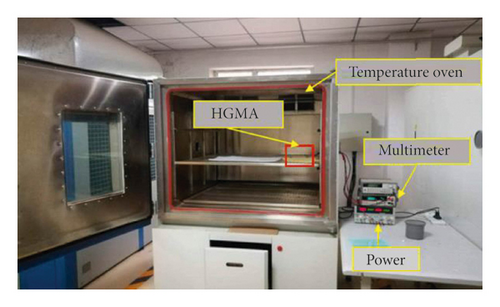
4.2. Result Analysis
It can be seen from Figure 9 that the output of the accelerometer changes significantly with temperature. First, we use three noise reduction models to compensate for the output of the accelerometer in the temperature experiment: EMD, wavelet thresholding, and EMD + wavelet thresholding. The EMD decomposition diagram is shown in Figure 10. It is well known that these signals are characterized by high-frequency noise and low-frequency drift. Therefore, after the EMD decomposition is completed, the SE algorithm is used to calculate the SE values of the decomposed 15 IMF components. Then, the 15 IMF components are segmented by the SE values. The 15 IMF components are decomposed into three segments [26]. In this paper, based on the characteristics of the 15 IMF components, we analyze that the signal sequence with SE greater than 1 is very complicated. It contains a lot of noise and belongs to the noise segment. Between 0.2 and 1 is a mixed segment of noise and signal and less than 0.2 is a noiseless drift segment.
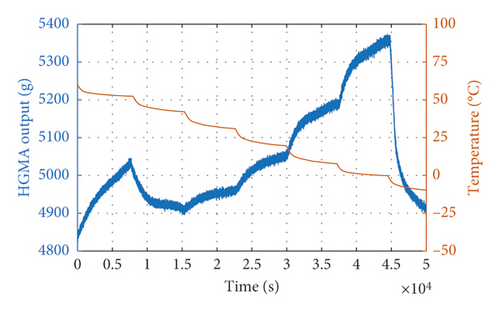
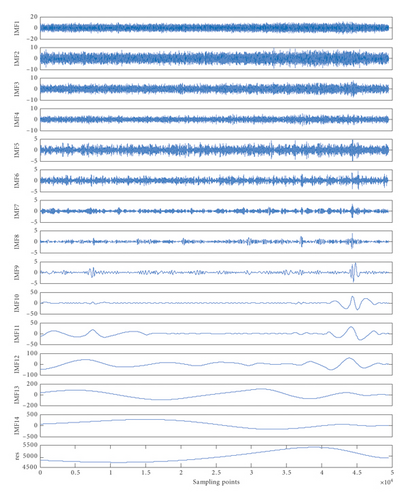
The first segment contains the first and second IMF components and is the noise segment C1; the second segment contains the third and fourth IMF components and is the mixing segment C2; and the third segment contains the fifth to fifteenth IMF components and is the drift segment C3, as shown in Figure 11.
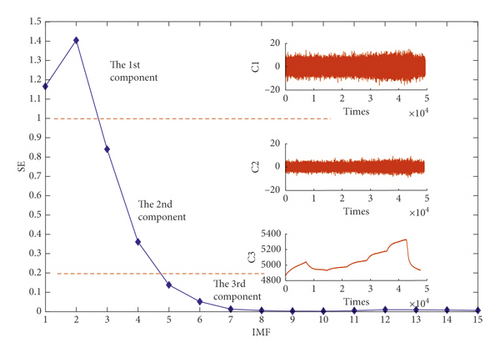
It can be seen from the Figure 11 that the noise segment is very rough, but the trend is stable. This indicate that this segment contains only a large amount of noise, and there is no drift phenomenon regardless of temperature. The mixing segment noise is significantly less than the noise segment but still contains noise. Its trend is smooth and there is no drift. The drift segment is no longer rough. We think it is only affected by temperature, causing drift and no noise.
After SE stratifies the signal, noise reduction models are developed. In EMD noise reduction, the first and second intrinsic mode functions are directly discarded because they are noise segments and are random and independent of temperature. The remaining components are used to reconstruct the signal. In wavelet threshold denoising, the “db5” wavelet is selected as the wavelet generating function. The decomposition scale is set to 5. And, wavelet threshold denoising is performed on the entire signal. In the EMD + wavelet thresholding method, the noise segment is discarded, the mixing segment is subjected to wavelet threshold processing, and the drift segment is left unchanged. Finally, the signal is reconstructed. The results from the three noise reduction models are shown in Figure 12.
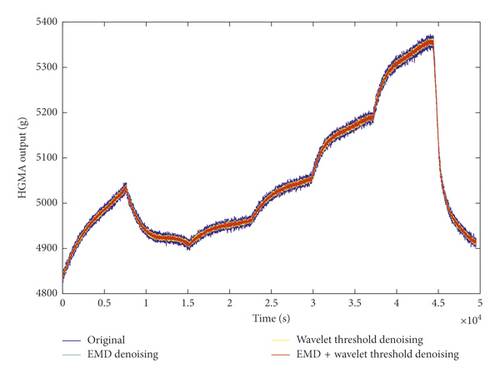
The results for each model are calculated. They show that all of the three models approximate the original data well. Of the three models, EMD and wavelet threshold have almost the same effect on noise suppression. The EMD + wavelet thresholding exhibits the best noise suppression. Then, using the results from noise reduction by the EMD + wavelet threshold method, GA-BP temperature compensation is implemented for the drift segment of the signal. So, an EMD + wavelet thresholding + (GA-BP) temperature compensation model is developed. Finally, C2 and C3 are reconstructed to obtain the final signal, as shown in Figure 13.
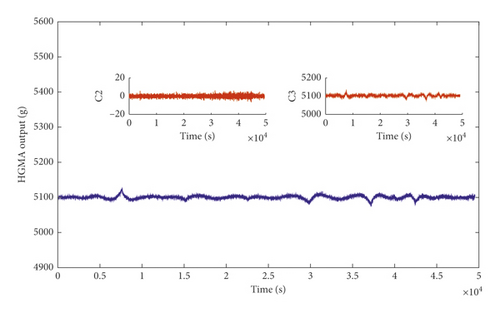
Allan variance [27, 28]is used to evaluate the noise reduction effect and temperature compensation effect of the four methods (Figure 14).

The results for the acceleration random walk (which represents the noise characteristics) and zero-bias stability are shown in Table 2. The data show that the values for the acceleration random walk that are obtained using the EMD, wavelet thresholding, and EMD + wavelet thresholding methods are 338.184 g/h/Hz0.5, 338.02 g/h/Hz0.5, and 207.518 g/h/Hz0.5, respectively. The corresponding values for the zero-deviation stability are 49275.9 g/h, 49274.7 g/h, and 49275.5 g/h, respectively. When temperature compensation is added, the values for the acceleration random walk and the zero-bias stability are 79.15 g/h/Hz0.5 and 774.7 g/h, respectively. It indicates that the accelerometer noise has been sufficiently suppressed and the temperature drift has been well compensated for. The main content of this paper is to propose a new signal processing method, which is a software processing method. The limitation of this method is that it cannot be processed in real time and must be completely collected before processing. Processing speed depends on how fast the computer software is running. The faster the computer runs, the faster the results will be processed. Our goal is to provide a more efficient signal processing method for the same or similar scholars refer to. In the future, we will continue to strengthen research in this field and strive to develop more effective and effective methods.
| Denoising | Temperature Compensation | |||
|---|---|---|---|---|
| Original data | EMD | Wavelet | EMD + wavelet | EMD + wavelet |
| B(g/h/Hz0.5) N(g/h) | B(g/h/Hz0.5) N(g/h) | B(g/h/Hz0.5) N(g/h) | B(g/h/Hz0.5) N(g/h) | B(g/h/Hz0.5) N(g/h) |
| 1712.66 | 338.184 | 338.02 | 207.518 | 79.15 |
| 49275 | 49275.9 | 49274.7 | 49275.5 | 774.7 |
5. Conclusion
In this paper, a fusion algorithm of EMD + wavelet thresholding + (GA-BP) temperature compensation is studied to improve the accuracy of a newly developed High-G accelerometer. The fusion algorithm first performs EMD decomposition on the original accelerometer signal to obtain IMF components. Then, IMF components are segmented by SE. The noise segment is directly omitted, wavelet thresholding is performed on the mixing segment, and a GA-BP performs temperature compensation on the drift segment. Finally, signal reconstruction is implemented. In the fourth part of this paper, EMD, wavelet thresholding, EMD + wavelet thresholding, and EMD + wavelet thresholding + temperature compensation results are compared by Allan variance calculation. And, the fusion algorithm is found to be the best. As shown by data, the acceleration random walk and zero-deviation stability change from 1712.66 g/h/Hz0.5 and 49275 g/h to 79.15 g/h/Hz0.5 and 774.7 g/h, respectively. This indicates that the fusion algorithm not only effectively suppresses the noise but also compensates for temperature drift in the accelerometer.
Conflicts of Interest
The authors declare that they have no conflicts of interest.
Acknowledgments
This work was supported by the National Natural Science Foundation of China (Nos. 51705477, 61703098, and 61603353) and Pre-Research Field Foundation of Equipment Development Department of China (No. 61405170104). This research was also supported by Top Young Academic Leaders of Higher Learning Institutions of Shanxi, Fund Program for the Scientific Activities of Selected Returned Overseas Professionals in Shanxi Province, Shanxi Province Science Foundation for Youths (No. 201801D221195), Young Academic Leaders of North University of China (No. QX201809), Open Fund of State Key Laboratory of Deep Buried Target Damage (No. DXMBJJ2017-15), and Fund for Shanxi “1331 Project” Key Subjects Construction.
Open Research
Data Availability
The data used to support the findings of this study are available from the corresponding author upon request.




